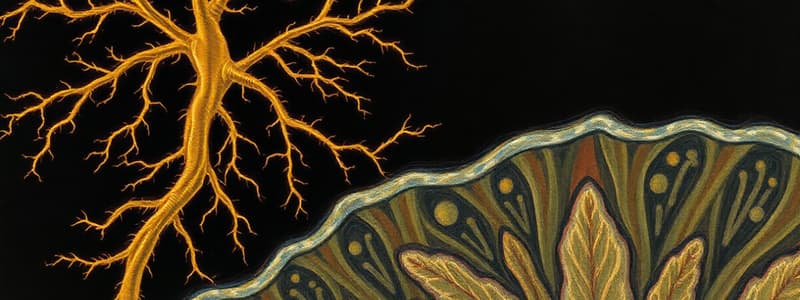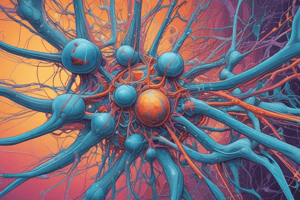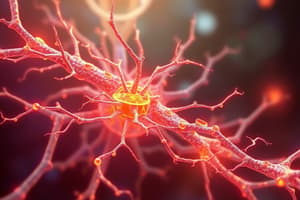Podcast
Questions and Answers
Which organelle is responsible for modifying products from the Endoplasmic Reticulum?
Which organelle is responsible for modifying products from the Endoplasmic Reticulum?
- Golgi Body (correct)
- Nuclear Envelope
- Vacuoles
- Lysosomes
What function do lysosomal enzymes perform best in?
What function do lysosomal enzymes perform best in?
- Basic pH
- Neutral pH
- Alkaline environment
- Acidic environment (correct)
Which type of Endoplasmic Reticulum is studded with ribosomes?
Which type of Endoplasmic Reticulum is studded with ribosomes?
- Cytosol
- Rough ER (correct)
- Smooth ER
- Lysosomes
What is the primary role of vacuoles in a cell?
What is the primary role of vacuoles in a cell?
Which statement about phagocytosis is true?
Which statement about phagocytosis is true?
What is the primary function of the cytoskeleton in a cell?
What is the primary function of the cytoskeleton in a cell?
Which of the following correctly describes microtubules?
Which of the following correctly describes microtubules?
What is the role of the centrosome in animal cells?
What is the role of the centrosome in animal cells?
Which of the following best describes microfilaments?
Which of the following best describes microfilaments?
How do phospholipids contribute to the structure of cellular membranes?
How do phospholipids contribute to the structure of cellular membranes?
What is selective permeability in relation to the plasma membrane?
What is selective permeability in relation to the plasma membrane?
Which structure is formed primarily from cellulose in plant cells?
Which structure is formed primarily from cellulose in plant cells?
What is the main purpose of cilia and flagella in cells?
What is the main purpose of cilia and flagella in cells?
Which feature is NOT common to both prokaryotic and eukaryotic cells?
Which feature is NOT common to both prokaryotic and eukaryotic cells?
What is the primary function of ribosomes in a cell?
What is the primary function of ribosomes in a cell?
What structure separates the nucleus from the cytoplasm in eukaryotic cells?
What structure separates the nucleus from the cytoplasm in eukaryotic cells?
Which of the following statements about prokaryotic cells is TRUE?
Which of the following statements about prokaryotic cells is TRUE?
What component of the nucleus is responsible for synthesizing ribosomal RNA?
What component of the nucleus is responsible for synthesizing ribosomal RNA?
Which of the following best describes the plasma membrane's function?
Which of the following best describes the plasma membrane's function?
Which of the following statements about cell sizes is correct?
Which of the following statements about cell sizes is correct?
What is the composition of the plasma membrane?
What is the composition of the plasma membrane?
Flashcards are hidden until you start studying
Study Notes
Cytoskeleton
- A network of fibers that helps support the cell and maintain its shape
- Provides anchorage for organelles
- Interacts with motor proteins to produce motility
- Made up of three main fiber types: Microtubules, Microfilaments (Actin filaments), and Intermediate filaments
Microtubules
- The thickest component of the cytoskeleton
- Hollow rods made from globular protein dimers called tubulin
- Help shape and support the cell
- Help in organelle movement
- Divide chromosomes during cell division
- Control the beating of cilia and flagella
Microfilaments (Actin Filaments)
- The thinnest component of the cytoskeleton
- Thin solid rods made from molecules of globular actin subunits
- Bear tension and resist pulling forces in a cell
- Reinforce cell shape and hold organelles in place
Cell Wall
- Extracellular structure that distinguishes between plant and animal cells
- Made up of cellulose microfibers embedded in polysaccharides and other proteins
Cell Wall Functions
- Protects the plant cell
- Maintains cell shape
- Prevents excess water uptake
Plasma Membrane
- The essential boundary separating the living cell from its external environment
- Selective permeability allows some substances to cross the membrane more easily than others
- Controls the exchange of materials
Phospholipids
- Most abundant lipids in membranes
- Found in the cytosol (free ribosomes), on the outside of the Endoplasmic Reticulum (bounded ribosomes), and on the outside of the Nuclear Envelope (bounded ribosomes)
Endomembrane System
- A group of organelles that work together to modify, package, and transport proteins and lipids
- Components include the nuclear envelope, endoplasmic reticulum, Golgi apparatus, lysosomes, vacuoles, and plasma membrane
Endoplasmic Reticulum
- A network of membranous sacs and tubules that extends throughout the cytoplasm
- Two types: Smooth ER and Rough ER
Smooth ER
- Tube-like and lacks ribosomes
- Synthesizes lipids
- Metabolizes carbohydrates
- Detoxifies poisons and drugs
- Stores calcium ions
Rough ER
- Surface is studded with ribosomes
- Has bounded ribosomes that secrete glycoproteins (proteins bound with carbohydrates)
- Produces transport vesicles
- The membrane factory for the cell
Golgi Apparatus
- Modifies the products of the ER
- Makes certain macromolecules
- Sorts and packages materials into transport vesicles
Lysosomes
- Membranous sacs with hydrolytic enzymes used for the digestion of molecules
- Lysosomal enzymes work best in the acidic environment of lysosomes
- Some sacs engulf others by phagocytosis, making a food vacuole
- Recycle cells by digesting dead organelles in a process called autophagy
Vacuoles
- Large vesicles derived from the Golgi apparatus and ER
- The inner solution is not like cytosol
- Function in storage and can help maintain turgor pressure in plant cells
Prokaryotic Cells
- Bacteria and Archaea
- Smaller than eukaryotic cells (1-5 micrometers)
- Lack a nucleus and membrane-bounded organelles
- DNA is unbound in the nucleoid
Eukaryotic Cells
- Protists, Fungi, Animal, and Plant cells
- Larger than prokaryotic cells (10-100 micrometers)
- Have a nucleus that contains most of the cell's DNA
- Have membrane-bounded organelles
Common Features of Prokaryotic and Eukaryotic Cells
- Plasma membrane
- Semifluid cytosol
- Chromosomes
- Ribosomes
Nucleus
- The membrane-bound organelle that contains the cell's hereditary information
- In eukaryotic cells, the nucleus contains most of the DNA; ribosomes use the information from DNA to make proteins.
Nucleus Structure
- Nuclear envelope: encloses the nucleus and separates it from the cytoplasm; consists of a phospholipid bilayer
- Nuclear membrane: double membrane; each layer consists of a phospholipid bilayer, which maintains the shape of the nucleus
- Nuclear pores: regulate entry and exit of molecules
- Nuclear lamina: protein filaments that maintain the shape of the nucleus
- Nucleolus: located within the nucleus; the main site for ribosomal RNA synthesis
- DNA is organized into discrete units called chromosomes; each chromosome is one long strand of DNA
- When DNA and proteins are bound, they form chromatin
Ribosomes
- Complexes of ribosomal RNA and proteins
- Carry out protein synthesis in the cytoplasm (free ribosomes) or on the endoplasmic reticulum and nuclear envelope (bound ribosomes)
Studying That Suits You
Use AI to generate personalized quizzes and flashcards to suit your learning preferences.





